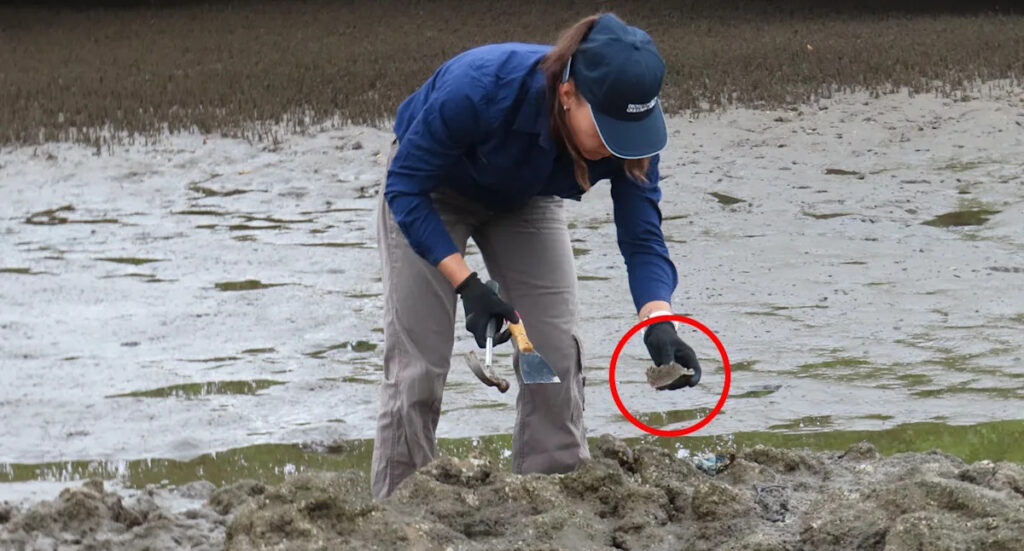
The battle against the invasive Suminoe oyster, a potentially destructive species newly discovered in Queensland, is intensifying. Authorities emphasize that the success of this fight largely depends on the vigilance and proactive measures of the Australian public. Recently spotted in the estuaries near Moreton Bay, this species poses a significant threat due to its rapid growth and potential to spread swiftly unless promptly reported by the public.
Suminoe oysters, which can grow larger than human hands, are challenging to distinguish from native species due to their similar coloration until they mature. The species can reach up to 24 centimeters in length and attain sexual maturity within just three months. This rapid growth rate is in stark contrast to the native Sydney rock oyster, which takes between two-and-a-half to four years to mature.
Public’s Crucial Role in Combating the Invasion
Dr. Carol Booth, in an interview with Yahoo News Australia, highlighted the critical role of the public in combating the spread of this invasive species. “It’s really up to the public. They’re the eyes out there, so if they find oysters they suspect are this oyster, they should report it, take a photo, and then report it to Biosecurity Queensland,” she urged.
Dr. Booth further emphasized the responsibility of boat owners in preventing the spread. “Boat owners really should be checking and cleaning, making sure their equipment and boats are clean and not spreading this species or other species. That message to boat owners is really important,” she added.
Risks Posed by the Suminoe Oyster
The introduction of the Suminoe oyster raises several ecological and economic concerns. Dr. Booth pointed out that these oysters, being edible and cultivated overseas, might have been introduced by human activity. Their rapid growth allows them to outcompete native oysters, potentially leading to significant ecological imbalances.
“The actual effects [of their spread] will play out in time, but the other really concerning aspect of when something like this arrives is whether they have any pathogens with them that are going to escape, jump hosts, and infect our native species,” Dr. Booth warned.
Unlike the Sydney rock oyster, which supports a long-standing aquaculture industry in Australia, the Suminoe oyster forms dense, aggressive reefs that smother seagrass beds and displace native marine life. This could erode biodiversity, reduce water quality, and damage habitats essential for fish and crustaceans.
Economic and Environmental Implications
The Suminoe oyster also poses a direct economic threat. In other regions, it has been associated with the spread of parasites and pathogens, complicating the efforts of native oyster farmers to maintain their stock. Additionally, its razor-sharp shells can litter shorelines, posing hazards to swimmers and beachgoers.
Dr. Booth drew parallels with other invasive species that have caused significant damage in Australia. “In Australia, we’ve lost frog species because of diseases like chytridiomycosis, caused by the introduced chytrid fungus. And we’ve got fish diseases brought in on aquarium fish or other live fish that have spread into the wild,” she explained.
“Increasingly, these pathogens are being circulated the world and finding new victims that have no immune response, which allows them to survive. The naivety of Australia, because we’re so isolated, means that new things coming in often find native species without any exposure and no response,” Dr. Booth added.
Looking Ahead: The Path Forward
The discovery of the Suminoe oyster in Queensland waters underscores the importance of public awareness and action in preventing the spread of invasive species. Authorities urge residents to remain vigilant, report any sightings, and practice responsible boating and fishing to protect Australia’s unique marine ecosystems.
As the situation develops, ongoing monitoring and research will be crucial in understanding the full impact of the Suminoe oyster and devising effective strategies to mitigate its spread. The collaboration between authorities, scientists, and the public will be key in preserving the ecological balance and economic stability of affected regions.







